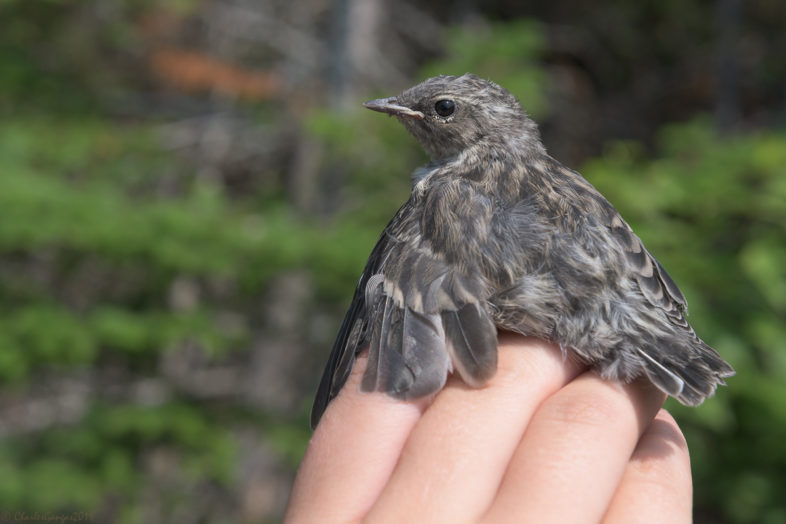
A stub-tailed juvenile Yellow-Rumped (Myrtle) Warbler, barely capable of sustained flight and surely not out of its nest more than 24-48 hours. Mt. Mansfield, 10 July 2019.© Charles Gangas
Week 6 of VCE’s 2019 banding season on Mt. Mansfield brought a second consecutive bump in numbers of mist net captures, and even a modest resurgence in vocal activity, but the ridgeline remains abnormally quiet. Tuesday evening and Wednesday morning featured classic mid-summer weather—warm temperatures, calm winds and a languorous haze. By nightfall, we had 16 captures in our 25 nets. Opening before first light the next morning, we added another 30 by noon, barely eclipsing last week’s season-high of 44 individuals.
We are now at 219 captures for the season, almost 64% of the 344 we had a year ago. The gap is closing, but numbers—especially of yearling (SY) birds—continue to be markedly low. Revising last week’s ratios of SY:ASY birds, one year ago, among the 50 Bicknell’s Thrushes we captured as of 11 July, we aged 25 birds as SY and 25 as ASY (after second-year, or 2+ year-old). This season that ratio stands at a very different 6 SY and 24 ASY birds. For Blackpoll Warbler, the trend is similar, though less pronounced—we captured 20 SY and 15 ASY birds by this date in 2018, 10 SYs and 10 ASYs so far this year. It’s difficult not to conclude that fewer yearlings of these and other species have returned to breed on Mansfield this year, for whatever reason(s).
The season’s first locally-hatched juveniles made an appearance this week, reassuring us that there will be productivity in 2019 and at least some recruitment a year from now. As usual, free-flying, streaky Slate-colored Junco fledglings were the first, as we captured two. Less expected were two stub-tailed Yellow-rumped (Myrtle) Warblers, each captured some distance from the other and therefore likely from different broods—neither could have been out of its nest more than 1-2 days. The next three weeks should, we hope, see many more “juvies” of different species.
Other Week 6 highlights were a pair of Cedar Waxwings (our first banded since 2017), which probably are not local breeders, and a strangely-plumaged Magnolia Warbler, which looked for all intents and purposes like a female, but showed a distinct cloacal protuberance (which only males develop) and no incubation/brood patch (sorry, no photos of that one…). We also recaptured a male Blackpoll Warbler in female-like plumage, a phenomenon we have seen previously (and even published a short paper on nearly two decades ago).
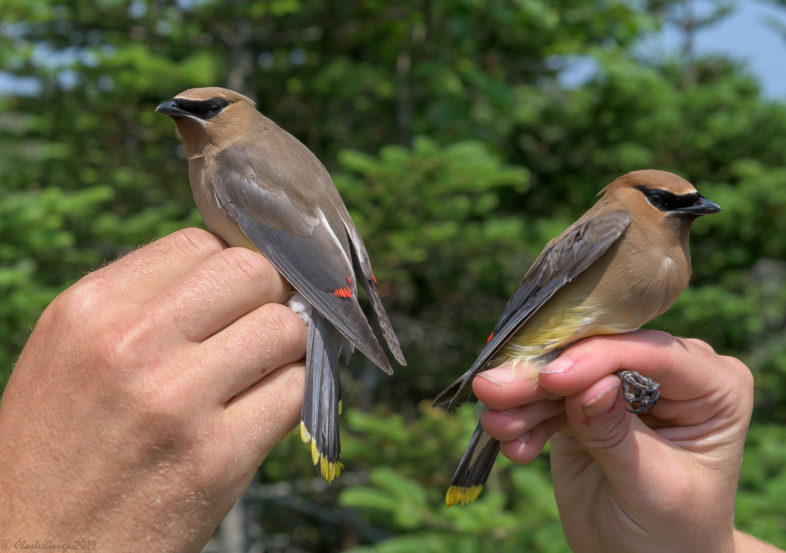
A pair of Cedar Waxwings (female on left, male on right), the first banded by VCE on Mansfield since 2017. © Charles Gangas
Our Week 6 tally included:
Winter Wren — 1 within-season recapture
Bicknell’s Thrush — 13: 2 new (1 male, 1 female), 1 male recapture from 2014, 10 within-season recaptures
Swainson’s Thrush — 1 new ASY male
American Robin — 1 new male
Cedar Waxwing — 2: pair captured together, but no evidence of local breeding (female w/o incubation patch)
Dark-eyed Junco (Slate-colored) — 10: 4 new females, 2 free-flying juveniles, 3 return males (1 from 2016, 2 from 2018), 1 within-season recapture
White-throated Sparrow — 2: 1 new female, 1 new male, 1 within-season recapture
Magnolia Warbler — 1 male (based on moderate cloacal protuberance) in female-like plumage(!)
Blackpoll Warbler — 4 new males (1 SY, 1 ASY), 2 within-season recaptures
Yellow-rumped Warbler (Myrtle) — 11: 2 stub-tailed juveniles, 2 new females, 7 within-season recaptures
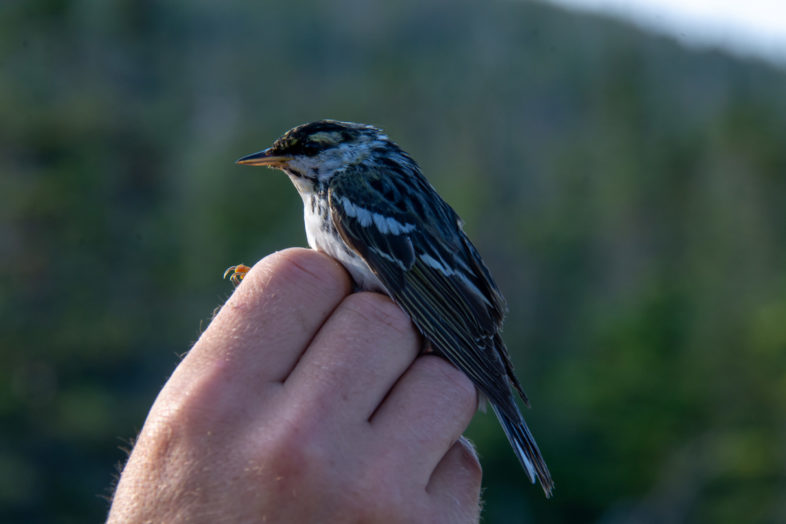
A strangely-plumaged male Blackpoll Warbler with partial female features, a phenomenon that VCE has documented at least twice previously on Mansfield. © Rich Kelley
It was encouraging to hear noticeably more bird song than during the previous couple of weeks, though overall volume was still low. We suspect that the presence of nestlings and fledglings stimulated this resurgence to some extent, as males “imprint” their species-specific song on the next generation. For anyone who hasn’t yet heard a Bicknell’s Thrush or Blackpoll Warbler sing this summer, it’s not too late.
Visitors always add a welcome dimension to VCE’s banding sessions on Mansfield, and this week was no exception. In addition to an enthusiastic group from Green Mountain Audubon, we enjoyed a visit from 5 year-old Beatrice (Bee) and her mom Eloise Girard of Craftsbury, and youngsters Eli and Willa Grimsley from CO, here visiting their grandmother Becky Williams and great aunt Charlotte Bill. All eagerly joined the bird-releasing action.
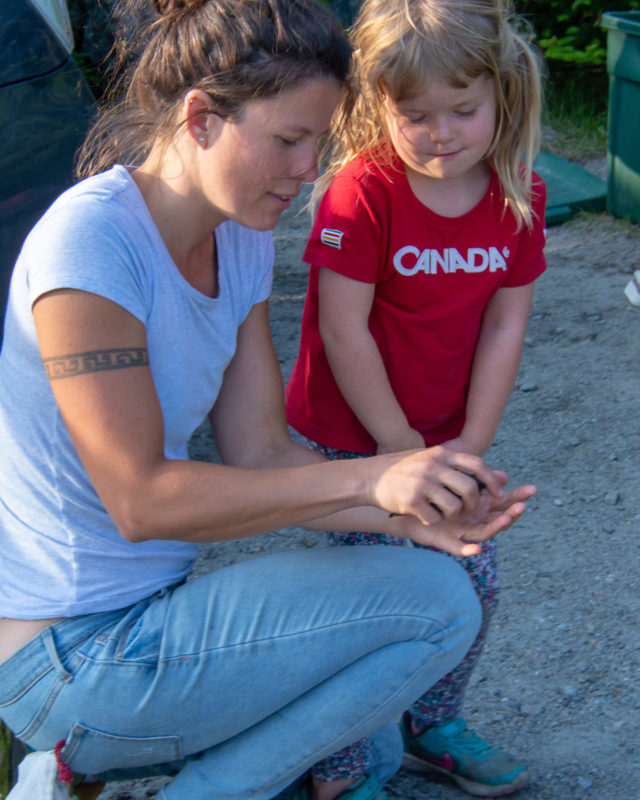
Eloise Girard and her daughter Bee prepare to release a banded bird on Mansfield, 9 July 2019. © Rich Kelley
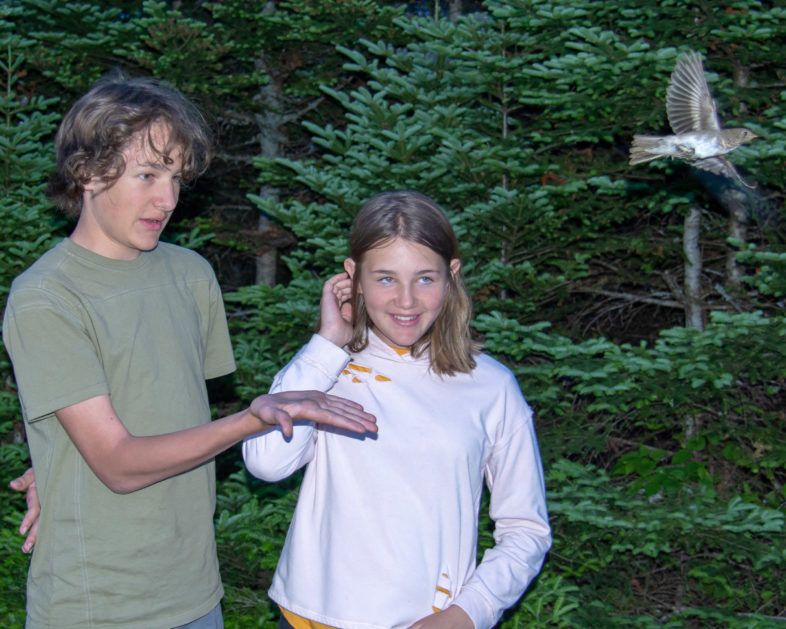
Eli Grimsley and his sister Willa watch a banded Bicknell’s Thrush zoom off after release from banding. 9 July 2019, Mt. Mansfield. © Rich Kelley

Thanks for the report on gynandromorphy. I saw a male (he sang) Common Yellowthroat with partial female feathering at the Crown Point banding station in May. Gordon says this is the second one CYWA they have banded. I notice all are warblers. Is this significant, or purely chance?
And thank you. for all your great work here and in the Caribbean.
Just how DOES one tell the difference between male and female waxwings??
Fantastic photo of the Grimsleys (expressions) and BITH is flight!